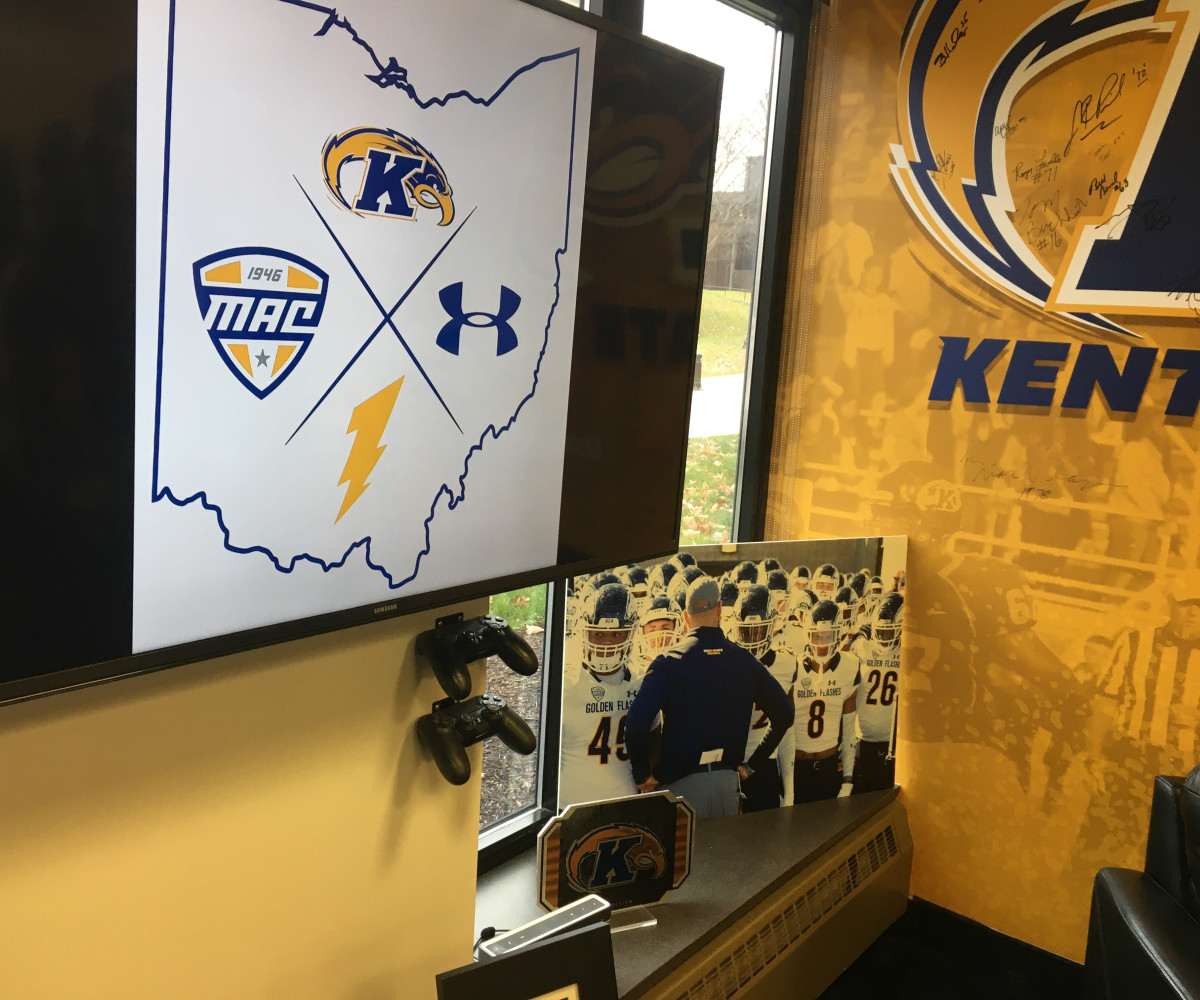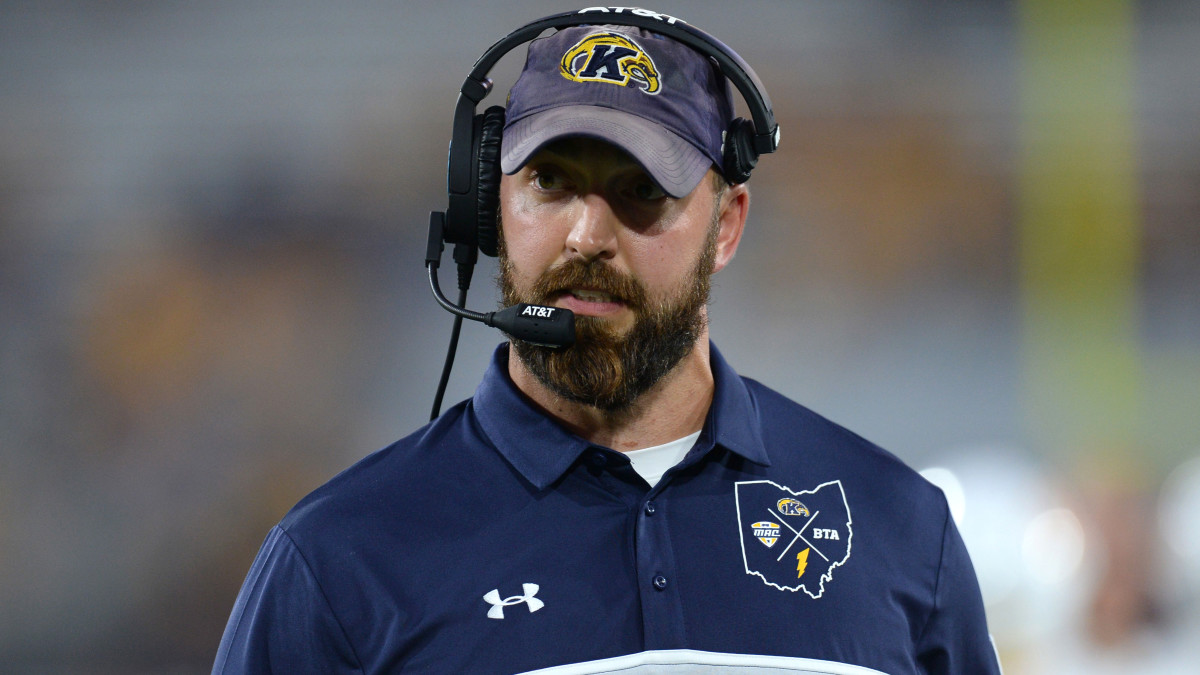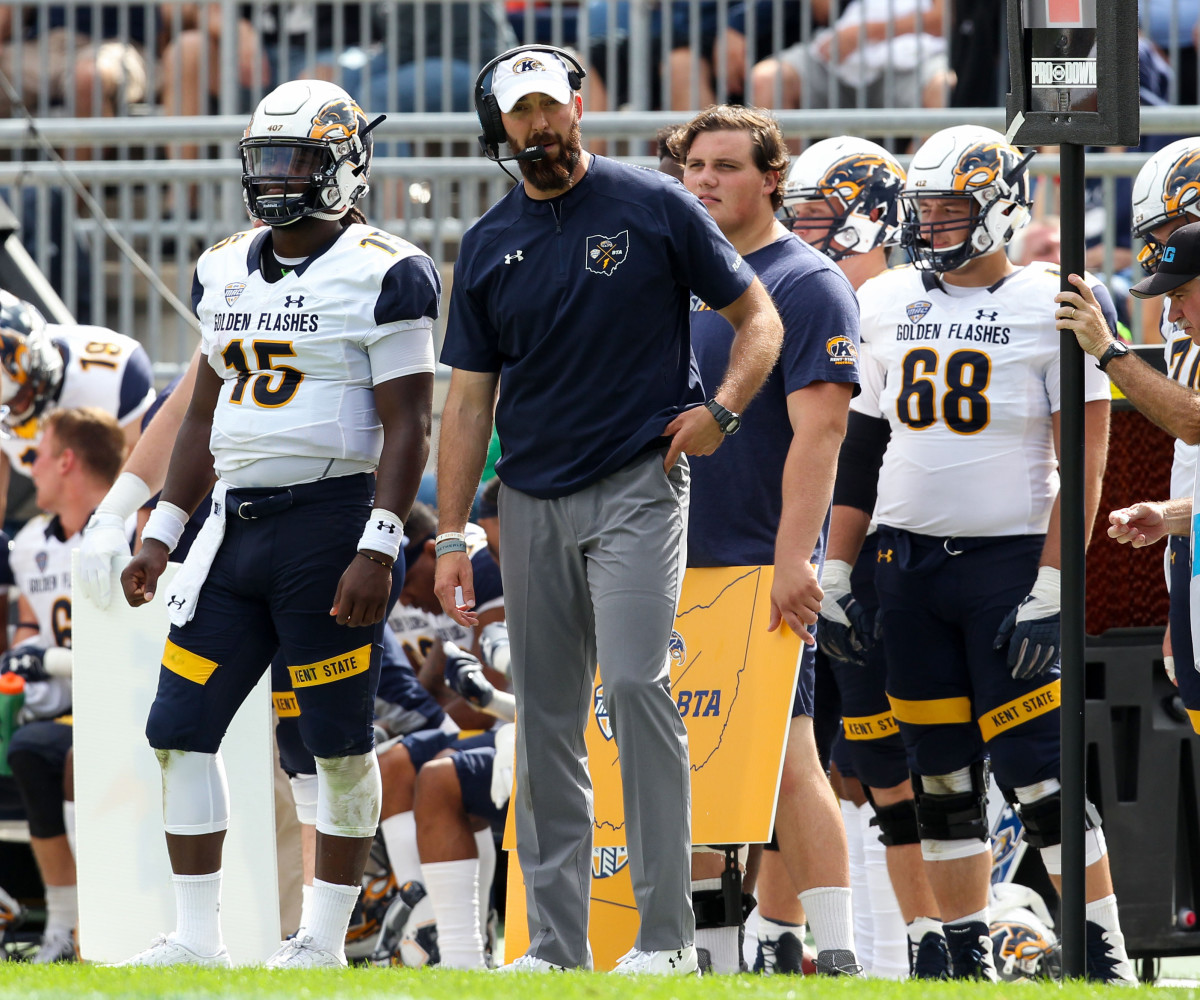Sean Lewis Is Bringing Kent State Football Back to Life
KENT, Ohio — Sean Lewis only refers to them as “the sticks.”
The sticks, two of them, are clipped against his office wall, beneath a PlayStation 4 tucked behind a television screen. The sticks are what bonds coach and player, what connects recruiter and recruit. The sticks bring together everyone here inside Lewis’s cozy office at Kent State.
In a way, he has structured his office around the sticks, positioning a leather sofa and a pair of leather recliners in front of that television screen. When the time is right, the sticks are unhooked from the wall, the TV flickers on and the PS4 buzzes to life.
It’s time to play video games—with the head coach.
“I’m very rarely in here by myself,” says Lewis. “This area kind of turns into a players lounge where the kids could come in and we play (NBA) 2K, Madden (NFL) and Call of Duty.”

At 34, Lewis is the youngest coach in the FBS, and he’s the tallest, too. At 6 foot 7, the long-legged former Wisconsin tight end lurches over his own players. He’s young enough to be a big-brother type. In fact, last season, Lewis was within 10 years of a 23-year-old sixth-year senior.
Many of his players know him as Uncle Lou, as in that cool, young uncle who protects you at the party but who you also respect. Don’t cross Uncle Lou and he’ll make sure no one crosses you.
Uncle Lou plays video games, downloads new Drake albums and pops Jolly Ranchers into his mouth from a communal jar on his desk. Uncle Lou is cool. He’s got a scraggly beard well past his chin, has shaved the top of his head and wears slim jeans like you.
On this Monday afternoon, he’s even whipped up a protein shake as if he’s about to head to a workout. “Got to get those calories,” Uncle Lou smiles.
Uncle Lou is, of course, Coach Lou, too. And Coach Lou, in his third season at the helm here, has one of the country’s most historically inept programs riding the fourth-longest winning streak in the FBS. The Golden Flashes have won seven games dating back to last year, are 3–0 for the first time in more than a half-century and have a chance this weekend, with a win at Buffalo, to move closer to its first conference championship since 1972, when Don James coached the team.
For a glimpse into this program’s football doldrums, Kent State is trying to complete just a fifth winning season in the last 43 years and consecutive winning seasons for the first time since Gerald Ford resided in the Oval Office—more than 10 years before its head coach was born.
This place is a football graveyard. Since 1978, the Flashes have had 12 coaches, and the only two who finished their careers with a winning record left for Power 5 jobs after Year 2: Glen Mason in 1987 (Kansas) and Darrell Hazell in 2012 (Purdue).
Explaining Kent State’s historic football woes is not easy, but coaching continuity is certainly an issue, says Bill Pakan, a former Kent State football player who is in his 30th year as the team’s orthopedic surgeon. Pakan’s first 10 years as the team’s doctor produced 14 victories, including two winless seasons.
“I can tell you I’ve heard more ‘We’re down 30 at half! Nobody’s job is guaranteed! We’ll see who really wants to play!’ type speeches,” he says. “I’ve seen so many staffs come through here. When you have success, you know that this is’t going to go on forever and that they’re going to move on if they keep this up.”
For a while, more than anything else, this place was known for the 1970 shooting, when four students were killed and nine wounded as the Ohio National Guard opened fire during an on-campus protest in what is known at Kent State simply as “May Fourth.” It scarred the university, a mark finally disappearing decades later. Pakan can remember attending basketball or baseball tournaments in KSU gear and hearing the whispers around him.
Oh that’s where those kids got shot.
This place has other demons, too. It is still haunted by a decision administrators made in 1987, when the school hired Dick Crum to begin a run of three coaches who won 18 games over a 10-year stretch. One of the finalists for the job when Crum was hired was a 37-year-old Kent State alumnus named Nick Saban, who eventually landed the Toledo job three years later, winning nine games in his only season there.
“You know, if we had hired Saban instead of him going to Toledo,” starts 33-year-old Casey Cegles, KSU’s deputy athletic director.
Resources here aren’t great. In fact, there is a do-more-with-less mantra across the campus. Kent State’s annual $29.4 million athletic budget ranks 114th nationally and is lower than 13 schools that play at the level below FBS. Throw in the weather of northeast Ohio and you have one of the FBS’s most difficult jobs.
The history is bad enough here that when hiring the last few football coaches, Joel Nielsen, in his 11th year as athletic director, has provided candidates with a list of hurdles attached to the job. The most notable is the department’s unusual strategy of playing three games annually against Power 5 programs, payouts that generate one-quarter of the department’s yearly revenue.
“Here’s the bad stuff,” Nielsen remembers saying to candidates, “you can leave if you want.”

And so it is understandable why some advised Lewis to turn down the job three years ago. Why didn’t he?
“All of us ball coaches think we can overcome any challenge,” he says.
He’s en route to leaping over college football’s biggest hurdle. He’s doing it with offensive fireworks, too, just as Nielsen had hoped. In searching for a coach after the 2017 firing of Paul Haynes, Nielsen turned to analytics. He wanted an offensive-minded coach.
Who around the nation is scoring the most points and touchdowns, picking up the most first downs and averaging the most snaps?
That led him to the Dino Babers–coached Syracuse Orange, whose co-offensive coordinator was 31-year-old Lewis. The Orange were 4–8 but had knocked off then-No. 2 Clemson and finished the 2017 season leading the country in snaps at 85.5 a game.
During the interview, Nielsen remembers the coach telling him and Cegles, “Guys, you just tell me how much you want me to snap it. I’ll snap it 100 times.”
Three years later, the Flashes are fourth nationally in snaps a game at 84 and they just set a MAC record for most points in a two-game span (131). On top of that, Lewis’s quarterback, Dustin Crum, is completing 75% of his passes and has thrown nine touchdowns and one interception. Kent State is as efficient as anyone. Take last week in a win over rival Akron: Crum completed his first 17 passes and the Flashes converted all 11 of their third-down attempts.
They’re no slouches on defense either and don’t think for a second that they are averse to running the ball. One of Lewis’s favorite plays is old-fashioned power football from his days as a player for Barry Alvarez and Bret Bielema at Wisconsin.
From afar, Alvarez has watched his former pupil.
“When you throw the ball around a lot, it’s very easy to lose toughness and it shows up on defense,” Alvarez says. “There’s a fine line there. He’s learned how to blend the two together, which is very unique.”
He’s done it with local products, too, once a rarity here.
Kent State football’s reputation has seeped into its past recruiting philosophy. The perception of the program among local players is as you’d expect—bad. So previous coaching staffs went outside of the state.
When Lewis took over, there were more players from Louisiana on KSU’s roster than Ohio. And now? The 31 Ohioans on the team are the most from any state.
“If you’re from Ohio, you know Kent State and that Kent State might not be that good at football,” Cegles says. “Lou said when he was hired, ‘I’m going to change that.’”
The Flashes enter this Saturday’s game against Buffalo (3–0) on more of a roll than any Kent State team since Hazell’s 11–3 squad won 10 straight. Fittingly, this seven-game streak began with a fourth-quarter comeback against the Bulls last season, when Lewis’s team, down 27–6 with eight minutes left, went on a tear: They scored a touchdown, recovered an onside kick, scored another touchdown, blocked a punt and scored a game-tying touchdown before the game-winning field goal.
The Flashes entered that game 3–6 having lost three straight one-possession MAC games. The old Kent State football doubt began to creep in. But Lewis stuck to his plan, the one he devised from watching Babers, Alvarez, Bielema and Wisconsin coach Paul Chryst, his coordinator and position coach in college.
Under Lewis, there is not an acceptance of the old Kent State football theme. Well, that’s the way we’ve always been.
“I’ve seen it in our fans for years,” says Nielsen. “When we get ahead in the fourth quarter, everybody tightens up. I’ve never been around that.”
Lewis is the son of a policeman raised on the south side of Chicago. Toughness was born in. In fact, he began his coaching career at his high school alma mater as the man in charge of detention. You can imagine the cast of characters he dealt with and the things he saw.

Even for his age, he’s somewhat unmoved by good news or bad. He remains at an even keel, and there are no excuses, period.
“Here, you get guys from big schools come in and the minute things don’t go well, they complain about, ‘Well, where’s our equipment for this or that,’” says Pakan, the team doctor. “You know what you signed on for. This isn’t the Big Ten or the SEC. You’ve gotta figure it out.”
The school president’s suite at the Kent State football stadium is Lewis’s quarterback meeting room. His tight ends meet in the ticket office. A giant tent erected outside of the locker room serves as the special teams meeting area.
And about those three games against Power 5 teams, Lewis shrugs. He uses a line from the 2004 Hollywood film Troy, when Achilles, played by Brad Pitt, is preparing to fight a Thesselonian warrior twice his size. A messenger tells Achilles that he would never want to fight that man. “That’s why no one will remember your name,” Achilles responds.
Lewis finished the story and smiles, “I wouldn’t be talking to you if we didn’t knock off Clemson.”
In the town of Kent, a suburb of Akron with a population of 30,000, interest in the Flashes grows. Lewis, in fact, already has a sandwich named for him at the downtown Kent eatery Twisted Meltz. The Sean Lewis is a double cheeseburger with bacon and jalapeños. He joins an illustrious group. Twisted Meltz also has the Nick Saban and the Lou Holtz, both of whom played at Kent State.
At another eatery in town on a Monday afternoon, there is buzz about the big game in Buffalo. But there is also worry. The concern isn’t about the game but about the head coach’s future.
Does he plan to stick around?
This place is so historically scarred that even a taste of winning brings on an appetite for loss. There is fear of another fleeting coach.
“He’s a special person and a special coach that we’d love to keep forever here,” Nielsen says, “but I’m a realist.”
Back in his office, Lewis’s concern is on the here and now. It’s time to ready game plans, prepare for practice and head to a meeting. Later, maybe when all the work is complete for the day, Uncle Lou and a few players will kick on that TV screen, switch on the PS4 and grab the sticks.
